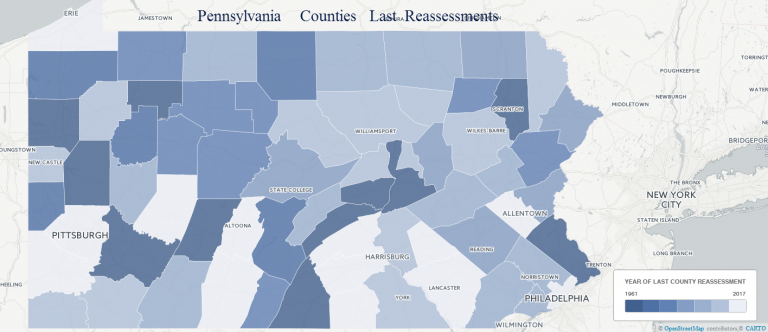State task force working to change Pa.’s property assessment rules in 2017

Some counties in Pennsylvania go without updating their property values for decades, far longer than the six-year maximum wait recommended by the International Association of Assessing Officers.
Some counties in Pennsylvania go without updating their property values for decades, far longer than the six-year maximum wait recommended by the International Association of Assessing Officers.
Almost everywhere else, revaluation is either handled at the state level or required at a set interval by state law, according to IAAO surveys.
This dubious distinction among policy wonks also has tangible impacts.
Revaluation can be expensive. But the longer governments wait, the higher the costs — and not only for the process itself.
Some property owners end up paying more taxes than they really should, for example, and many go to court to fix it. This adds legal defense fees to the millions of taxpayer dollars revaluations required even in counties with a relatively small number properties.
Schools and county and local governments, meanwhile, often are left with an inaccurately assessed tax base. This can prevent them from capturing revenue for road repairs, education, police and fire services and other community needs.
The state’s Reassessment Reform Task Force has been trying to improve the situation.
What’s next?
The task force will meet Jan. 26 — about eight years since the group started working on the issue. It’s a complex matter and, until people are affected, probably not provocative enough for a re-election campaign talking point. Fear of that changes, once implemented, might prevent an incumbent’s next term also plays a role in the process taking as long as it has.
Lawmakers have repeatedly prioritized other matters over the years. So when task force members meet next, they’ll try to come up with a plan for implementing some changes that don’t need legislative approval, according to Local Government Commission Executive Director Phil Klotz.
The LGC heads the task force. It also includes the State Tax Equalization Board, legislators and their research staff, and lobbyists and policy analysts focused on assessment and city and county government issues. The group has consulted with IAAO as well.
Their 2017 agenda likely will include reforms that do require lawmakers to act as well, Klotz says.
Possible changes
Pennsylvania does have a process for estimating property values between countywide reassessments:
Counties submit property sales data to the State Tax Equalization Board every year. STEB uses the latest data and past information to guide counties in estimating values for properties that haven’t changed hands in the past 12 months.
But major errors have turned up in past examinations of STEB’s work, found through the task force’s own research and an investigation by the state Auditor General’s office.
STEB has worked in recent years to improve its formulas and process with help from the International Association of Assessing Officers, but that only goes so far, says County Commissioners Association of Pennsylvania Executive Director Doug Hill.
Hill and Klotz shared some potential next steps:
Set statewide data collection and training standards.
County assessors must be a certified property evaluator. But counties contract with data collectors according to their own standards.
Counties also aren’t consistent in how they submit property sales information STEB. Sometimes it’s not electronic. And they differ on providing details about properties and transactions. STEB uses those details to eliminate outliers (a process called trimming) that would throw off estimation guidelines. Let’s say, for example, a property previously assessed at $250,000 is transferred between family members for $1. STEB wouldn’t use that for a guideline. But Hill says the state should establish codes to flag outliers for trimming and indicate the reason (examples include family transfers and sales involving public utilities, governments and nonprofits).
Developing a quantitative trigger for reassessments, or at least considering one. Basically, the formula would flag officials once a particular percentage of a tax base’s property assessments depart by a certain degree from market values.
Splitting the bill for tax base-wide reassessments among counties, municipalities and school districts. Right now, counties cover all the costs, even though other public entities — public schools, municipalities, etc. — depend on property values for revenue and can suffer negative consequences when they’re outdated. Taxpayers still would be responsible, ultimately, for the full cost of a revaluation. But splitting the expense among governing bodies would quell the political fears that can delay assessments long past due.
Editor’s note: This story was updated to clarify political optics involved in reassessment reform.
WHYY is your source for fact-based, in-depth journalism and information. As a nonprofit organization, we rely on financial support from readers like you. Please give today.



